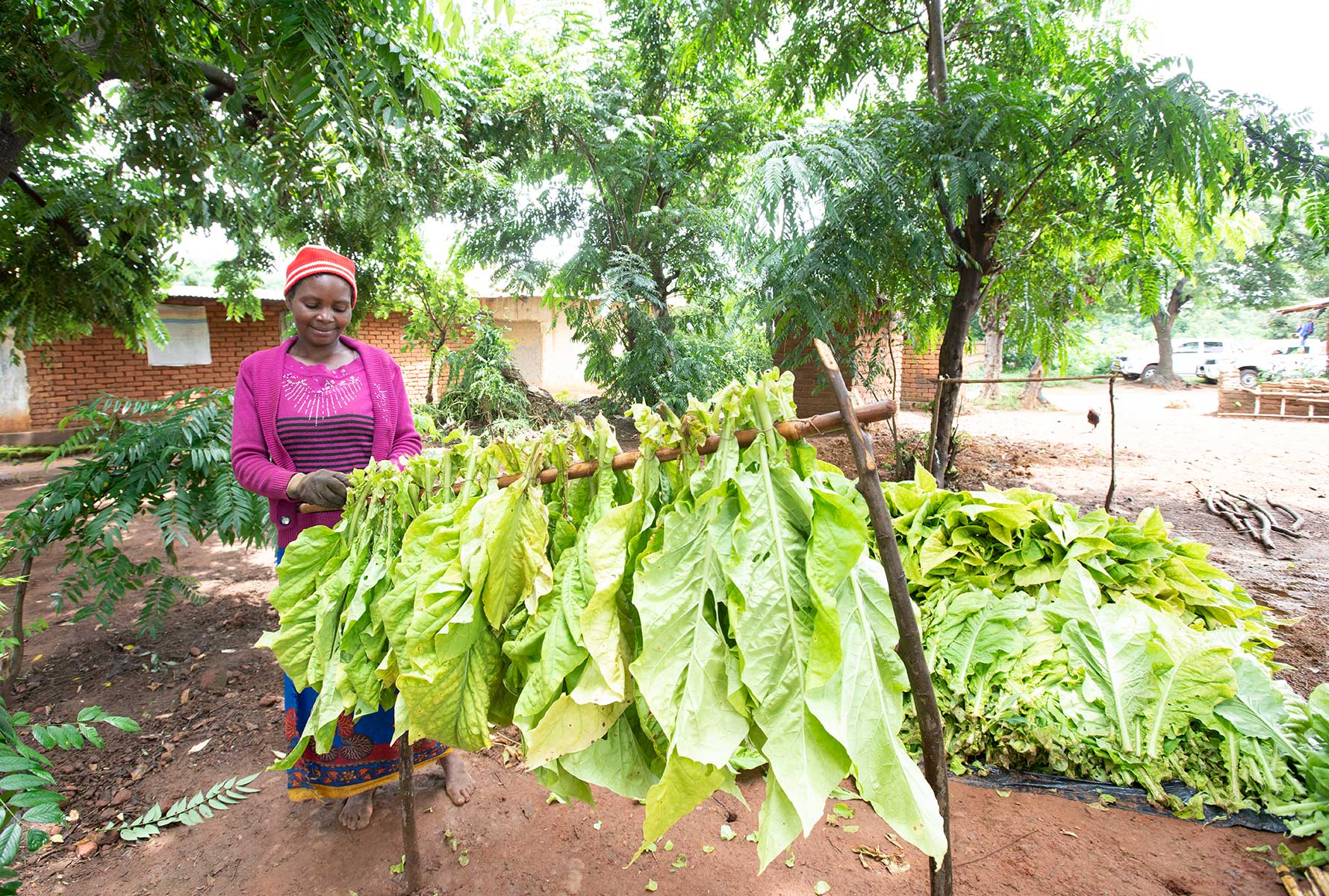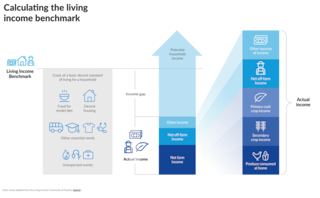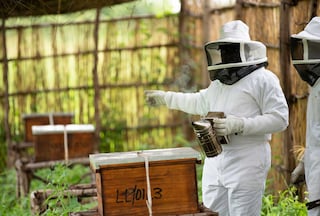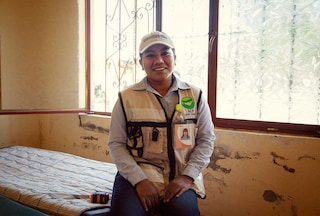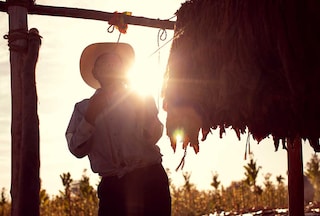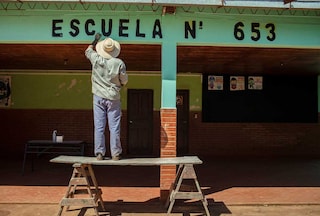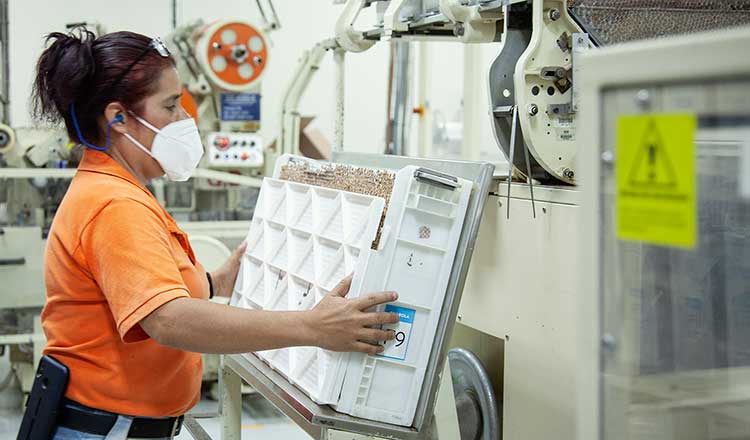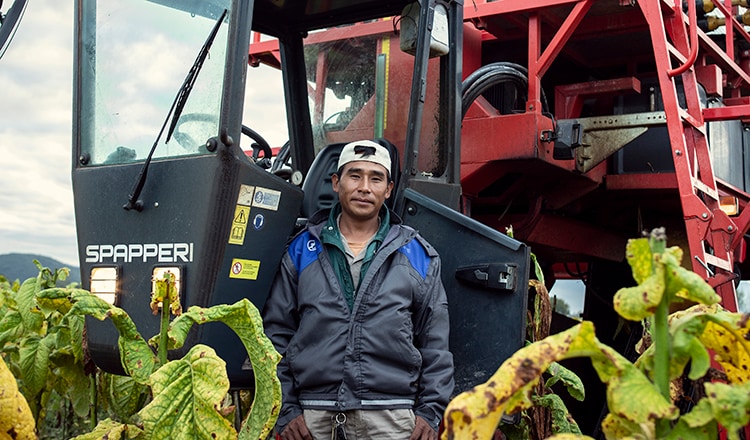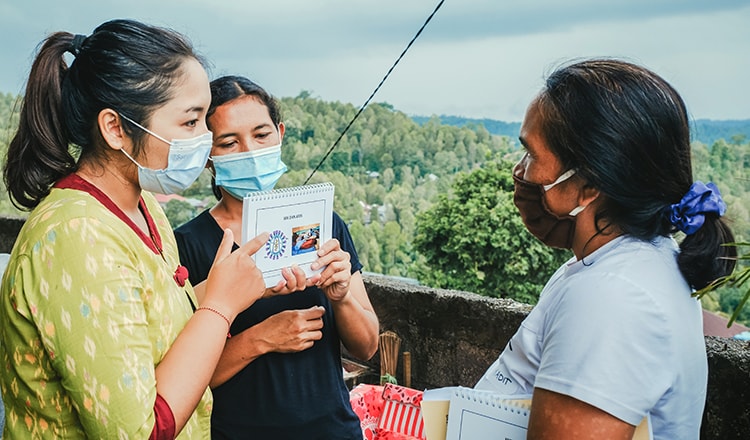Impact of COVID-19 on our activities in 2020
Protecting the health and safety of field technicians, farmers, workers, and their communities
read moreContributing to alleviating poverty
PMI is committed to improving the livelihoods of the contracted farmers supplying tobacco to the company and, consequently, the communities in which they live. We see this as a fundamental way to address social inequality, as well as other issues in our supply chain.
Assessing income levels in our tobacco sourcing markets
To be able to achieve our ambitious goal of 100 percent of contracted farmers supplying tobacco to PMI to make a living income by 2025, we started by performing our own analysis to help us identify those markets where there is a gap between the farmers’ current income levels and the living income benchmark. Our priority is to focus our efforts on those markets with the greatest gaps.
In order to validate the initial outcome of our internal analysis, we approached various organizations with expertise in the living income calculation field, such as the Global Living Wage Coalition and the Living Income Community of Practice. As a result of this engagement, we decided to adopt the Anker methodology, which is widely recognized to estimate living income benchmarks worldwide.
Moreover, in 2020 we started our partnership with Social Accountability International and the Living Income Anker Research Network to conduct living income studies, comprising both living income benchmarks and reference values.1
During the year, we ran two living income benchmark studies in Malawi and Pakistan. Due to the COVID-19 pandemic, we could only secure partial results (i.e., based on secondary data only) and, in 2021, we expect to have access to the primary data needed for the completion of the studies. In addition to this, we completed three living income reference values in Argentina, Mozambique, and Turkey, which were used in the design of comprehensive action plans that will help address the income gaps over time.
In parallel, we conducted farmer income studies in Malawi, Mozambique, Pakistan, the Philippines, and Turkey to assess the current income levels of our contracted farmers. We are using local and international partners in these countries. We had planned to conduct a farmer income study in Argentina; however, due to COVID-19 and the travel restrictions, this was delayed to 2021.
1see Glossary.
In this chapter
- Impact of COVID-19
- Contributing to alleviating poverty
- Calculating the living income benchmark
- Our Living Income program at work
- Enabling access to water, sanitation and hygiene
- Promoting PMI's Agricultural Labor Practices
- Eliminating child labor
- Promoting a safe working environment
- Minimum wages for workers
- Next steps

Socioeconomic well-being of tobacco-farming communities - topic overview
read morePMI has taken an important step by using the Anker methodology, which is recognized around the world as the gold standard of living wage and income estimates. Using such rigorous, independent studies of the income levels required for a decent standard of living is a critical component for PMI if they are to credibly achieve their target by 2025. To date, Anker studies have been performed in 60 locations in over 40 countries. The new studies commissioned by PMI will not only support PMI’s ambitious goal for their contracted farmers, they will be made publicly available and add to global efforts on living wages and income.
The results of the third-party studies are encouraging as they do not highlight major deviations from our initial assumptions. This provides us with confidence in the prioritization of our markets as we work toward our 2025 target.
It also showed that our contracted farmers already make a living income in some markets, such as Pakistan, or that a significant portion of them already make it in other countries, such as Argentina, Malawi, Turkey, or the Philippines. Globally, in 2020, 48 percent of the contracted farmers supplying tobacco to PMI were making a living income.
We expect to further examine and act on insights from these studies in 2021. The results will complement our internal analysis and help to guide our efforts and target initiatives toward reaching our target of 100 percent of our contracted farmers making a living income by 2025.
PMI has set an ambitious target of 100% of their contracted farmers achieving a living income by 2025. To be able to achieve this objective, our Anker Living Wage and Income Research Network, together with Social Accountability International (SAI), have worked with PMI to conduct living income benchmarks and reference value studies in their tobacco sourcing countries. The living income studies will use the research methodology we developed, which is widely used by many leading companies and sustainability standards. As a start, in 2020 PMI commissioned us to estimate the living income for tobacco farming areas in five countries. This will allow them the visibility on the required income levels for their contracted farmers to be able to achieve a decent standard of living and develop strategies in those markets where income gaps have been identified.
Initiatives to improve livelihoods
In 2020, we continued implementing various initiatives aimed at improving income levels. Based on our internal analysis, we focused primarily on Argentina, Malawi, and Mozambique. While activities are tailored to local realities, our overall strategy is twofold: Firstly, on the tobacco crop to improve productivity and competitiveness and secondly, as needed, on supporting households to diversify their sources of income.
Improving productivity
We focus on enhancing tobacco production and encouraging farm efficiency. To improve household income, many farmers routinely seek out efficiencies in their operations—for example, by hiring only the labor required, making careful use of inputs such as fertilizer, and finding ways to increase yields per hectare. PMI supports these efforts. Additional efficiencies include supporting the mechanization of field preparation, which can provide labor savings and elevate yields.
For instance, in 2020 mechanization for field preparation covered a total of 2,115 hectares in Malawi while, in Argentina, the main focus of activity was on mechanized harvesting, with a total of 3,566 hectares covered in 2020. Additionally, we continued with improved crop storage to reduce the potential financial loss from crops spoiling and the need for insecticides after harvest.
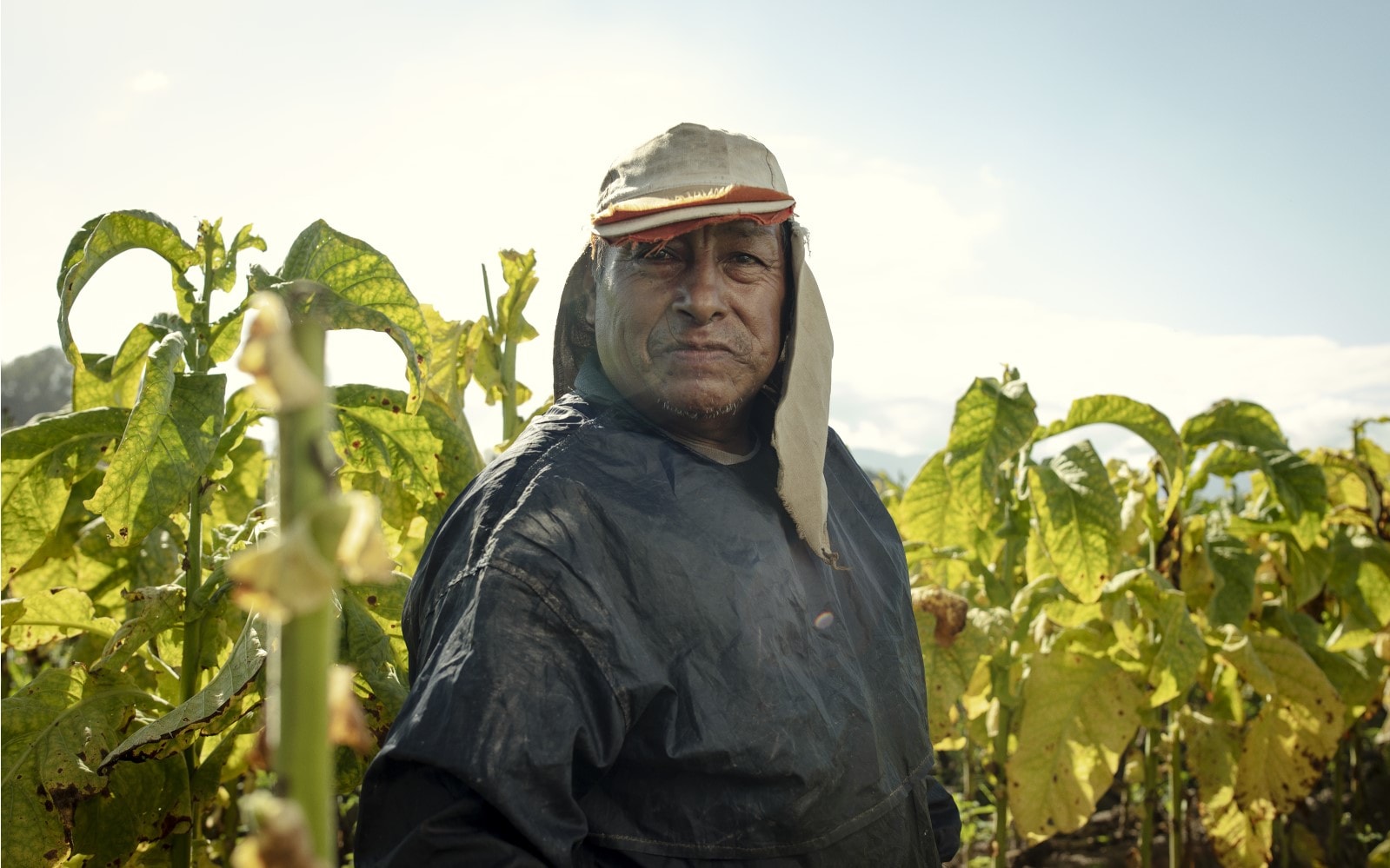
Case study
Advancing income levels of farmers and farmworkers in Argentina
Supporting households to diversify their income sources
We also look at opportunities to implement other income-generating activities, such as the cultivation of complementary crops. Growing and marketing a range of crops can improve farm income while enhancing resilience against climate change and economic uncertainty. In 2020, we estimate that approximately 75 percent of our contracted farmers grew crops other than tobacco. Of these, 53 percent was intended for self-consumption, 10 percent was aimed at providing additional income, while 37 percent was grown for both self-consumption and additional income.
Enhancing access to water, sanitation, and hygiene
While substantial progress has been made in increasing access to clean drinking water and sanitation, billions of people worldwide—mostly in rural areas—still lack these basic services. The link between poverty and limited access to water, sanitation, and hygiene (WASH) is well established, and enhancing WASH infrastructure can provide substantial improvements to both the well-being and livelihoods of community members. The COVID-19 pandemic has also further demonstrated the critical importance of sanitation, hygiene, and adequate access to clean water to prevent and contain disease.
In 2020, we strengthened our approach and committed to ambitious targets: We aim for 100 percent of our contracted farmers to have basic water access by 2025 and sanitation and hygiene by 2030.
To set those targets and develop our framework, we aligned with the Joint Monitoring Programme for Water Supply, Sanitation, and Hygiene (JMP) established by the World Health Organization (WHO) and UNICEF.1 Our WASH program is following JMP´s service ladder, which starts with basic water access defined as from an improved source and less than 30 minutes away. Currently many of our farmers are using unimproved sources, often more than 30 minutes from their home, which means that the next few years will be focused on monitoring WASH access, mapping water source locations, and building new infrastructure (or improving existing infrastructure) where needed. In 2020, we also developed global WASH Monitoring Guidelines to standardize our approach (again connecting with JMP) and have shared these with our suppliers. In 2021, we will collect WASH data through farm-by-farm monitoring in the field, applying JMP’s universal indicators to determine our final WASH priority markets, setting a baseline for each of them.
During the year, together with our suppliers, we continued the work started in 2019 in our two preliminary priority countries, building 47 hand-pump boreholes in Malawi and 50 in Mozambique—with each borehole estimated to benefit approximately 500 people in Malawi and 1,000 people in Mozambique —while continuing to raise awareness around WASH among community members. The economic benefits of improved sanitation can include increased productivity, reduced healthcare costs, and the prevention of illness, disability, and early death. People who have access to clean, safe, and convenient sanitation services also experience greater dignity, privacy, and security. This is especially important for women and girls, who may miss work or school when they are menstruating and do not have access to safe sanitation facilities. It also reduces the risk of sexual assault by reducing the walking distance to water sources.
1WHO/UNICEF Joint Monitoring Programme for Water Supply, Sanitation and Hygiene (JMP).
Empowering women in tobacco farming
Around the world, women participate in agriculture both as members of family farming households and as hired wage labor on farms owned and operated by other households or companies. Agriculture remains the primary source of livelihood for both men and women living in rural areas in developing countries. Globally, only 13 percent of agricultural land is owned by women.2 Many of the gender inequalities faced by women are exacerbated for women in agriculture. More concretely, women involved in tobacco farming often face structural and cultural barriers such as employment segmentation and gender gaps in earnings, financial inclusion and access to credit, ownership of land and property, and opportunities to receive training or technical support. Women typically also have to balance their financial contribution to the household with domestic responsibilities, which puts additional constraints on their time, and too often they still lack the authority to manage the income generated from the crops they produce. Additionally, girls tend to have higher school dropout rates, reinforced by gender norms that limit their possibilities. To break this cycle and overcome the dropout problem, policies need to be put in place and enforced, improving educational access and retention while simultaneously reducing gender inequality.
2 Report of the UN Secretary-General's High-Level Panel On Women's Economic Empowerment.
Since the inception of our ALP program, gender equality and fair treatment have been included as key principles in all the countries where we source tobacco. Gender equality is not only a fundamental human right but a necessary foundation for a peaceful, prosperous, and sustainable world. When we evolved our ALP program to include a Step Change approach in 2018, our objective was to address the root causes of the most prevalent and persistent issues in our tobacco supply chain. We saw an opportunity to strengthen our approach, considering the instrumental role women play in improving household economic conditions, while also addressing child labor and other social challenges.
We included women’s empowerment as one of the 10 principles of our Step Change approach. Based on local needs, we are developing targeted initiatives in several priority countries.
Our activities include conducting focused women’s training, hiring female field technicians to perform farm-by-farm monitoring, financial literacy training, and empowering women through entrepreneurial opportunities to bring positive change to their households and communities.
A representative example of our work on women’s empowerment is found in India. Alongside the local NGO, ASSIST, we support Self Help Groups (SHGs) developed by local government. In 2020, we rolled out a project with the aim to build entrepreneurial capabilities of 200 women, members of the SHGs, by training them on financial and organizational skills. ASSIST uses a “train the trainer” approach equipping selected women with knowledge to empower and train others after them. Some 100 women from 11 SHGs, after having received training, have been selected to set up their own microbusinesses; these include dairy farms and grocery stores. In turn, they will support the funding of microbusinesses for 100 new beneficiaries, creating a positive domino effect. The approach is that all women participating in the project are committed to support other women within the community by donating a portion of their profit to ensure continuity, reach, and greater impact. In 2021, we plan to train an additional 200 women who can in turn further cascade their knowledge and provide funding for 100 additional women.
Promoting PMI’s Agricultural Labor Practices
In 2020, field technicians contracted either by PMI or by our leaf suppliers systematically monitored the implementation of ALP on 93 percent of all contracted farms (2019: 92 percent). We are committed to continually strengthening our monitoring to improve our visibility of existing issues, to taking a more risk-based approach, and to more effectively address identified issues. Our farm-level data cover 21 out of the 23 countries from which we source. It excludes Lebanon and Switzerland1 but accounts for increased coverage of our ALP program in China.
Across the countries from which we source tobacco, the most recurrent and difficult problems are as follows:
- Work performed by children
- Inadequate and unsafe accommodation for farmworkers
- Payment to workers below the minimum legal wage or formalized agricultural benchmark
- Inadequate access to PPE that can prevent harm from exposure to CPA and GTS
1 In Lebanon, we source through the state-run tobacco monopoly and do not receive granular information at farm level. In Switzerland, where we sourced from around 120 farmers in 2020, we aligned requirements with peer companies to apply deeper ALP monitoring to be included in our 2021 reporting.
We have developed and are implementing action plans to address these recurrent issues in collaboration with key stakeholders, including our strategic partner Verité, local NGOs, and governments. While Control Union was able to finalize their assessment in Argentina (covering two suppliers) early 2020, due to COVID-19 no additional external assessments were conducted during the year. However, local expert organizations were able to complete external verification in some priority countries. External verification allows us to evaluate the effectiveness of our initiatives and the accuracy of our internal monitoring. In 2020, we completed external verifications in seven markets: Three where we conducted an external verification for the first time (India, Malawi, and Mozambique), and four where we did it for the second time, in order to assess progress (Argentina, Indonesia, Mexico, and Turkey).
Furthermore, in 2020 we conducted a human rights impact assessment in Mozambique, the first one targeted on our tobacco supply chain, in collaboration with a peer company and our common tobacco leaf supplier. This assessment focused on identifying and addressing human rights risks and impacts resulting from our production and supply chain activities there.
The overwhelming majority of our relationships with contracted farmers feature a shared commitment to continuous improvement in addressing social issues. In the event of a contracted farmer’s noncompliance and a continued failure to address gaps identified, we may end our business relationship with that farmer. In 2020, 1,794 contracts were terminated due to ALP violations (up from 641 in 2019). Some 83 percent of the increased number of contract terminations in 2020 was due to child labor violations, predominately coming from Mozambique and Turkey. The increase can be attributed to the introduction (in 2019) of standardized guidelines related to due diligence, consequence management, and rewards.
To further support compliance, in 2020 we reviewed our ALP training materials (including some developed locally) and delivery methods. In terms of content, our objective is to update the training materials to align with changes on the ALP code, reflect changes driven by our Step Change approach, and bring consistency across sourcing markets. When it comes to delivery methods, we are exploring options and potential solutions accessible to all people working within our ALP structure, including suppliers’ relevant personnel and field technicians.
Eliminating child labor
In 2020, we maintained a relentless focus on preventing incidents of child labor. Our robust due diligence system allowed us to identify risks and incidences of child labor and take immediate action.
Our ambitious goal is to eliminate child labor by 2025. Our objective is to eradicate cases that are repetitive and systemic in our tobacco supply chain. We also acknowledge that isolated cases (even when systemic occurrences are fully addressed) might continue occurring, due to farmer base turnover or unintentional misbehaving incidences. We will, in all cases, remain alert and tackle them promptly when identified.
The COVID-19 pandemic and the restrictions introduced in several sourcing countries unfortunately impacted our initiatives and relevant child labor remediation actions. Nonetheless, a key focus was to ensure that there would be no increase in child labor prevalence due to school closures and economic slowdown.
First of all, our field technicians, where possible, continued performing farm-by-farm monitoring and supporting farmers to address and remedy child labor incidences. Such support included awareness-raising and training (often redesigned to be delivered virtually); efforts to promote school access and attendance through scholarships, school feeding programs, afterschool activities, and improvements in school infrastructure; vocational training for older children; and initiatives to improve household income levels such as women’s self-help groups.
In markets where community initiatives, key to preventing child labor, could not be implemented due to restrictions, programs have been redesigned and funds reallocated to ensure continuous support to children and their families. For example, in Mexico, PMI-funded migrant childcare centers were closed due to the pandemic. In response, and in partnership with our supplier and a local implementing partner, we delivered food baskets to more than 180 migrant families reaching over 370 children that could not attend the centers. A similar approach was taken by our team in India, where food baskets were provided to over 800 families who were under full lockdown.
Our progress toward our target of zero child labor is measured based on internationally defined ILO standards. It includes the following three categories: Children performing hazardous tasks, children under 15 hired, and children under 13 doing any tobacco related tasks. In this respect, in 2020 we enhanced our reporting on child labor issues by expanding its scope to include the latter two categories. During the year, field technicians monitored 99 percent of farms for child labor related issues and recorded a total of 2,352 prompt actions. Out of that, 2,285 cases involved children performing hazardous tasks (versus 2,712 recorded in 2019), three cases of children under 15 hired, and 64 cases of children under 13 working. In total, these prompt actions involved 2,502 children, with 95 percent of them being the farmers’ children. A significant proportion of child labor incidents (1,560 prompt actions) were recorded in Turkey across a farmer base of around 23,600 farms. These involved 1,692 children, of which over 99 percent were family members. The predominant activities performed by these children were harvesting or handling green tobacco and stringing.
Regarding prompt actions raised for children performing hazardous tasks, there is a reduction from 2019 figures mainly driven by farm base consolidation efforts conducted in Mozambique and Malawi. Of the 2,352 prompt actions recorded in 2020, 75 percent were resolved and the remaining 25 percent were being followed up against the action plans developed with concerned farmers. This is a decline from the previous year, mainly due to local initiatives impacted by COVID-19 restrictions. The most common hazardous tasks our technicians found children doing were harvesting or handling green tobacco (49 percent), followed by stringing (26 percent) and working with sharp tools (9 percent).
Despite this decreasing trend, we remain cautious and acknowledge the limitations of our monitoring system. For example, field technicians are only present on the farms for a limited time during the growing season, and the COVID-19 pandemic restricted their ability to conduct regular visits in some countries (read more: Sustainable supply chain management). Moreover, the issues we face are complex and often persistent.
In many geographies, external assessments related to child labor are reasonably well aligned with our internal monitoring data, which show that we are enhancing the visibility on the ground and the accuracy of our data. However, in two countries, Mozambique and Turkey, significant discrepancies were revealed. In those instances, we focused on engaging our suppliers, understanding the causes of discrepancies, and developing and implementing action plans to strengthen the internal monitoring. More concretely, we increased the number of unannounced visits performed by ALP supervisors, strengthened the due diligence and consequence management process, and reinforced internal capacity on ALP monitoring and reporting while introducing in-depth data analytics. Both countries will reconduct external verification in 2021.
Zero child labor
Our target to eliminate child labor by 2025 is ambitious. We have put all the foundations in place to be able to achieve it on time: A robust farm-by-farm monitoring system, a network of field technicians and ALP experts, external assessments verifying our data accuracy, and a range of stakeholders supporting us in this journey. We are dealing, however, with a very complex societal issue, especially present in some of our sourcing markets. In order to increase the accuracy of the instances of child labor prevalence in our reporting, we developed a new methodology integrating results from third-party verification as well as external sources (e.g., country human rights records). This supports our risk-based approach and provides us with country-level granularity on this specific topic. Based on this exercise, we feel confident that in most of our sourcing countries, child labor is not a systemic issue and we are continuously working to eliminate the remaining prevalence of 3.5 percent. We will maintain a relentless focus on further strengthening the reliability of our monitoring data, as well as the remediation steps to support farmers and workers to address child labor incidents in a sustainable way.
Promoting a safe working environment
In line with PMI’s ALP Code, we require farmers to provide a safe workplace to prevent accidents and injury and minimize health risks.
In 2020, field technicians recorded a total of 10,816 prompt actions relating to unsafe working environments (2019: 10,519). Around 52 percent related to handling green tobacco and applying CPA without the proper PPE (34 and 18 percent, respectively), followed by 23 percent related to unsafe or insufficient accommodation for farmworkers.
Our internal monitoring data over the past few years revealed that a significant proportion of the prompt actions raised by field technicians pertained to exposure to green tobacco sickness (GTS) or to crop protection agents (CPA) due to the farmers and workers not wearing the proper PPE. To address this issue, we committed that 100 percent of our contracted farmers and their workers would have access to PPE for the application of CPA and prevention of GTS by 2020. During the year, our monitoring on PPE availability confirmed the achievement of the 2020 target.
Having achieved our target, we will continue ensuring full availability of PPE across the markets and raising awareness on the importance of appropriate PPE usage. Acquiring the fundamental understanding of the hazards of certain tobacco tasks and driving behavior change toward appropriate PPE usage is key to safeguard the health and safety of those involved. In 2020, our targeted training reached 99 percent of contracted farmers (and their workers).
In 2021, we will establish our baseline in terms of PPE usage and, based on the outcome, we will define our target—as our goal is to ensure that PPE is not only available but also appropriately used by farmers and farmworkers.
We also continued our work regarding accommodation. In 2020, around 8 percent of the total farmer base provided accommodation to their workers. In line with the ALP Code, when a farmer provides a worker with accommodation, we require it to be clean and safe and meet basic standards. We developed our accommodation standards in line with local legislation, with guidance from Verité and local partners. Field technicians monitor against these lists and when issues are identified, for example the window is broken or waste is improperly thrown out, action is taken. Specific action plans are agreed directly with the farmer and, when needed, together with our suppliers, we support with the provision of construction materials, refurbishments, and repairs. By the end of 2020, 100 percent of farmworkers receiving accommodation had been provided safe and adequate accommodation that met the above-described standards.
Thinking ahead, we already reinforced our requirements by issuing a set of global minimum accommodation standards to be implemented across all sourcing markets. This was the result of an extensive mapping exercise between local practices in all sourcing markets and relevant international standards. Additionally, following the commitment related to our Water Access, Sanitation and Hygiene (WASH) program, relevant requirements have been included in these guidelines. This approach brings not only better standardization and consistency but will further enhance the living and working conditions for farmers and workers. In 2021, we will roll out these new standards to our tobacco leaf suppliers.
Minimum wages for workers
Income earned during a pay period, or growing season, should be enough to meet workers’ basic needs. Our ALP Code requires that the wages of all workers (including temporary, piece-rate, seasonal, and migrant workers) meet—at a minimum—the national legal standard or formalized agricultural benchmark standard. In a typical crop year, less than a third of contracted farmers supplying PMI or its suppliers (over 100,000 farmers) hire workers throughout the season.
In 2020, our monitoring on wages covered 92 percent of contracted farmers in our tobacco supply chain. In 2020, 65 percent of farmworkers were paid at least the minimum wage. Field technicians recorded a total of 1,541 prompt actions related to farmers paying less than the minimum wage to their workers (2019: 1,158). The increase in prompt actions is mainly due to more accurate monitoring and reporting of cases. The issues are most commonly found in India, Indonesia, Mozambique, the Philippines, Turkey, and the Misiones province in Argentina.
In 2020, our monitoring on wages covered 92 percent of contracted farmers in our tobacco supply chain. In 2020, 65 percent of farmworkers were paid at least the minimum wage. Field technicians recorded a total of 1,541 prompt actions related to farmers paying less than the minimum wage to their workers (2019: 1,158). The increase in prompt actions is mainly due to more accurate monitoring and reporting of cases. The issues are most commonly found in India, Indonesia, Mozambique, the Philippines, Turkey, and the Misiones province in Argentina.
The challenges relate to not only substandard payment amounts but also informal terms of employment, inconsistency between supply and demand of labor, and workers’ lack of knowledge on their rights. Another challenge we face in some countries is the lack of applicable legal minimum wage or formalized agricultural benchmarks. Read the example of Argentina in our case study.
Improved visibility on workers’ wages via our monitoring system enables us to take steps to tackle the issue and ensure farmers pay the required minimum wage. We reiterated our expectations to farmers on this matter, in line with local laws. We also equipped farmers and workers with tools—such as time-recording templates and payment records—to help them track work hours and calculate payments in line with the minimum wage, a task that can be challenging when piece-rate payments or partial in-kind payments are the norm.
In countries where the pay gap is significant, we provided financial literacy training to farmers and supported them in improving their farm productivity and efficiency—and, thus, their overall incomes—to better position them to pay the minimum wage to their workers. A key component of this effort is helping farmers manage their costs responsibly by only hiring workers when necessary and according to their land size. In Mozambique, for example, our supplier ran an awareness campaign on over-hiring that discouraged farms of 0.67 hectares and below to hire full-time workers, which resulted in a 60 percent reduction of farms hiring full-time workers in this category.
In certain geographies, there are important challenges to formalizing minimum wages. For instance, in India, where a national minimum wage is a challenging issue, our third-party assessment showed that several farmers were paying below the minimum wage and that women workers often were paid less than men for the same type of work, in clear violation of the ALP Code. Informality of the labor employment has been one of the biggest challenges in enforcing compliance with the national legal minimum wage. Workers are commonly hired for certain tasks and they are paid through different payment terms such as daily payment, volume based, and piece rate. And it is common that farmers and workers agree on a fee, which although in line with prevailing community rates, is often lower than the legal minimum wage. To understand better the complexity of this issue, in 2020 we conducted a desk research with the support of twentyfifty, a human rights and business consultancy. The objective of this research was to understand the factors influencing the wage setting mechanism in the agricultural sector through stakeholder engagement of different companies and organizations. The key finding from this benchmarking exercise is that awareness, lack of documentation of wages, and enforcement of national minimum wage is still weak. Furthermore, we expect that our efforts to promote a living income for our contracted farmers will in turn help advance income levels for their workers. Our main focus in that regard will be to increase farmer’s efficiency and productivity. We will also explore the introduction of mechanization for different tobacco stages. On top of that, given the vulnerability of women in the rural economy, we also developed projects on capacity building and financial training, as well as self-help groups that work with existing governmental programs and microbusiness initiatives.
2020 performance highlights
-
48%
of contracted farmers who make a living income
-
100%
of farmers and farmworkers having access to personal protective equipment for CPA application and GTS prevention
-
3.5%
prevalence of child labor among farms contracted by PMI directly or by PMI’s tobacco suppliers
-
100%
of tobacco farmworkers provided with safe and adequate accommodation (when applicable)
Next steps
In 2020, we reached important milestones, achieving two ALP Step Change targets:
- 100 percent of contracted farmers and workers having access to PPE
- 100 percent of tobacco farmworkers provided safe and adequate accommodation
We will continue to work toward achieving our 2022 and 2025 targets.
2021 marks the 10th year anniversary of PMI’s ALP program. We plan to celebrate the progress and achievements of our ALP program, publishing a dedicated report. We will continue publishing quarterly Progress Updates on specific topics or countries.
We will continue to strengthen our monitoring of the implementation of our ALP Code and improve our effectiveness and consistency in responding to identified issues. We will pilot our newly developed learning framework to further build capabilities and understanding of our requirements among field technicians and within the ALP community. In addition, we will conduct external verifications in Argentina, Mexico, Mozambique, Pakistan, the Philippines, and Turkey. We also expect Control Union to conduct assessments in China and Indonesia in 2021—if pandemic-related conditions allow.
Most importantly, as we continue to expand our monitoring of child labor incidents beyond hazardous work, we will aim to also analyze the impact of our initiatives using indicators developed with our expert partner Verité. This will allow us to further refine our work on child labor, safe working environments, and minimum wages.
We expect to issue a revised version of our monitoring guidelines on Step Change priority areas, as well as new guidance on WASH. These will be shared with our suppliers and will bring further consistency, clarity, and standardization. In 2021, we will also develop a WASH training video to raise awareness among our field technicians and farmers about what “WASH” stands for, how it impacts their health and well-being, and why PMI will be continuously monitoring water access, sanitation, and hygiene. This video will be shown on a tablet to farmers in the field and will be available in multiple languages for easiest understanding. We will continue strengthening our WASH program on the ground, and specifically in Malawi and Mozambique, where we will start focusing on rehabilitating unusable boreholes.
A key focus for 2021 will be to continue implementing our strategy to ensure that contracted farmers achieve a living income, drawing on insights from the living income studies and farmer income surveys conducted in 2020. In 2021, we will continue to expand the geographies to perform living income studies, by covering the Philippines, India, Greece, Mexico, and Brazil. In addition to this, we will initiate third-party farmer income studies in Argentina and Mexico while continuing to strengthen and monitor our internal analysis of farmers’ incomes.

Performance metrics
view dataThis online content about our Integrated Report should be read in conjunction with PMI’s 2020 Integrated Report. The information and data presented here cover the 2020 calendar year or reflect status at December 31, 2020, worldwide, unless otherwise indicated. Where not specified, data come from PMI estimates. Please also refer to 'About this report' on page 3 of the 2020 Integrated Report for more information. Aspirational targets and goals do not constitute financial projections, and achievement of future results is subject to risks, uncertainties and inaccurate assumptions, as outlined in our forward-looking and cautionary statements on page 145. In the 2020 Integrated Report and in related communications, the terms “materiality,” “material,” and similar terms, when used in the context of economic, environmental, and social topics, are defined in the referenced sustainability standards and are not meant to correspond to the concept of materiality under the U.S. securities laws and/or disclosures required by the U.S. Securities and Exchange Commission.
